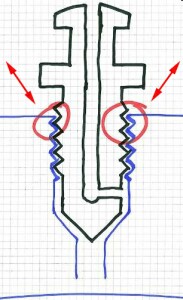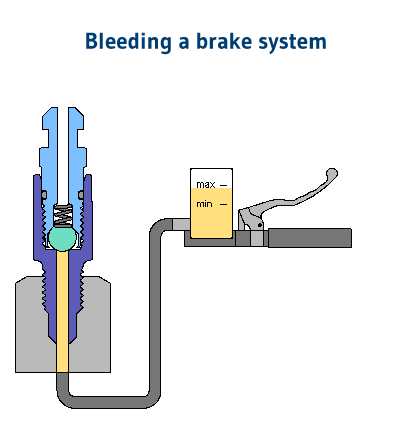What is the difference between the stahlbus Bleeder Valve and other products?
Comparison to conventional bleeder valves
 The opened thread of the conventional bleeder valve is not (!) air-tight. Therefore, there is always some air leaking in during bleeding/filling the system, reason for which vacuum systems (vacuum pumps) will not work adequately, and brake fluid may escape through the thread.
The opened thread of the conventional bleeder valve is not (!) air-tight. Therefore, there is always some air leaking in during bleeding/filling the system, reason for which vacuum systems (vacuum pumps) will not work adequately, and brake fluid may escape through the thread.
Constant opening and closing of the conventional bleeder valve causes such a wear of the aluminium thread in the calliper that it will continuously be expanded over time. At the worst, the calliper will eventually fail. This happens particularly in racing.
The stahlbus® Bleeder Valve is inserted in the calliper once, and there it remains. Because only the upper part of the valve is detached, the calliper is no more subject to wear.
Owing to the built-in O-ring, the stahlbus® Bleeder Valve is invariably tight. After its use, the upper part is tightened to the bottom part and perfectly seals the system (the ball cannot move anymore).
Comparison to a hose with non-return valve at its end
This system does not solve the problem where it arises. As the thread of the conventional bleeder valve still does not seal completely (as it has to be opened once) air will continue to leak into the brake system. In addition, you cannot determine whether the air bubbles in the hose originate from the brake system or have been “dragged” through the thread at the time of bleeding the system.
However, a considerable disadvantage is the excess pressure building up in the hose during pumping, which often leads to the hose blowing off the bleeder valve and the brake fluid spouting out and soiling the entire surroundings. The alleged possibility to adjust the counter-pressure of the non-return valve only works to a very limited extend.
It is not possible to use vacuum systems (vacuum pump) for this system, as refilling of the brake system, e.g. after having fitted steel overbraided hoses (Stahlflex) to it, is not supported.
The stahlbus® Bleeder Valve solves the problem where it arises. The brake system is directly sealed off by an O ring.
The use of vacuum systems does not create any difficulties and, due to the complete tightness, it allows to refill the braking system in no time and even without expensive vacuum pumps. The simple and cheap stahlbus® Vacuum Refill and Bleeder Device is absolutely sufficient.
Comparison to the Speed Bleeder
This system from the US uses a non-return valve instead of the conventional bleeder valve, and first glance it works the same than does the stahlbus Bleeder Valve. However, the differences become clear during operation. The thread is sealed with a sealing paste which has to be exchanged, if the case may be, in order to reduce the problems of the conventional bleeder valve.
The non-return protection is achieved by an inserted spring-loaded ball for bleeding the system with pumps.
In contrast thereto, the ball of the stahlbus® Bleeder Valve sits in a cage. This allows lifting it actively from the sealing when detaching the upper part by two turns. Thus, also vacuum systems (vacuum pumps) may be used without any problems. Nevertheless, the O ring tightens the entire system reliably and permanently.

Some general information:
Only the stahlbus® Bleeder Valvecombines all the advantages in one system:
- Absolutely tight due to O ring.
- Reliable nun-return function which allows for unassisted operation.
- Possible use of vacuum or excess pressure systems.
- No wear of the thread in the calliper.
- Can be used for hydraulic brakes and clutches.
{fcomment}














